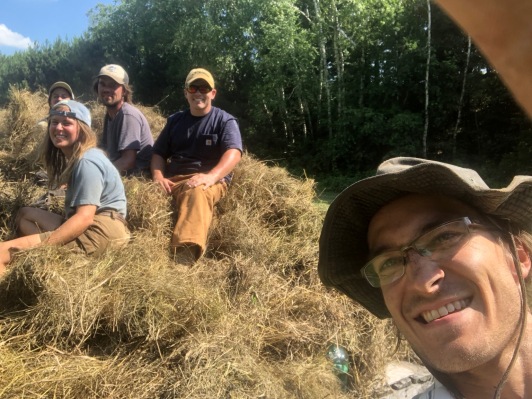Hay Doggin’

Having grown up in a farming community and worked on numerous dairy farms in my younger years, I’ve often witnessed the odd and inextricable inclination of every real farmer to wake up on the hottest day of the summer and say: “Today is a Hay-Day.” Such was the impulse of my colleagues on Tuesday, and, much to my chagrin, upon arriving at Rising Sand, I found Oren and Polly engaged in the early stages of just such a hay-day.
Their methods were, I must admit, a bit odd. In spite of our brand new used flat-rack hay wagon parked behind the barn — purchased specifically for this purpose — they employed our tiny Gator: cruising out to the middle of the field to pick up loose piles of hay left over after our last bailing, heaping the gator to well over its limited capacity, and returning to our south zucchini patch. Polly was driving, while Oren engaged in an awkward crouching sprawl atop the precarious pile, to hold it in place for the drive. I waited by the bed as they returned, taking an irresistable picture of the Grandmaster in an uncharacteristically compromised position. “I resent you for taking that.” He informed me. “Think we should get the wagon out?”
“Um, yes.”
Generally avoiding hay-duty due to the exacerbation of my asthma from the dust, I agreed to be the tractor driver- pulling the wagon at a slow crawl while Oren and Polly ran and picked up the clumps of loose leftover hay, and returned to heap them atop our flat-rack wagon.
Here I should interject that the activity of the day was mulching. I, frankly, love mulch. While I came to organic farming for the food and radical activism, I stay for the mulch. I’ve written tomes about it. Basically, mulching involves placing a thick layer of carbon material (usually leaves or hay) around established plants, to stifle additional weed growth and add back carbon that’s lost in the removal of crops. Covered soil also remains cooler, and retains moisture much better than bare soil, minimizing irrigation requirements, greatly reducing weed pressure, and leading overall to healthier plants. There are few better feelings in farming than looking upon a heavily mulched bed, knowing that it’s taken care of for the present and foreseeable future.
Driving an old tractor through an open field at slow speed is a close second, though, and I contentedly enjoyed my seat as Oren and Polly ran armfuls of hay back and forth. This bliss lasted mere minutes before I became unnerved by seeing Oren — whose typical work pattern involves a lot of, well, standing around — in continuous motion. I stopped, hopped off the tractor, and started running hay bundles, thus wordlessly signing up for a dusty and muggy afternoon of hay-doggin’.

Polly, Oren and I took care of the first round around the field, returning to the zucchini patch with a heaping load, which Monica and Ross (one of our worker share members) helped unload and mulch. Load #2, though accompanied by more folks, seemed to take much longer, as the blistering sun wore us and slowed our trudging pace. Even Lotus the Dog only lasted for a couple of minutes, before returning to the shade to chew on his fresh deer leg from Logan’s kill. After what seemed like hours, I called to Oren on top of the wagon and suggested that we call it a load. “How about if we just catch this corner quick? he replied. “5 more minutes.”

Knowing that Oren’s 5 minutes is a sick time mutilation at best; and downright fallacy at worst, we groaned and trudged along, until even our loftiest tosses could no longer land comfortably atop the massive pile. I drove back slowly, giving my associates a much needed moment of stagnance on the wagon.
To the beds we returned, to mulch green onions, beets and pumpkins. Polly and Oren headed out, to make their Ultimate Frisbee game, suggesting first that we’d better empty the whole wagon, in case of overnight rain. Mulch we did and mulch we did, until only Monica, Kelly and I remained. Slowly, the hay pile shrunk as we trudged back and forth, back and forth between rows of hearty veggies. At some point, from the depths of our tired and amicable conversation, Kelly dropped the bomb. “I thought there would be a bigger crew here to help us eat the giant watermelon.”
Giant watermelon?!
Apparently, Melissa had scourged through the produce overflow department of the Coop, and designated a watermelon specifically for Rising Sand Organics. When, finally, we dogged our way to the bottom of the hay pile, we took a moment to bask in the glory of a heavily-mulched plot, before walking up the hill to the table in the shade, to celebrate with a big plump wedge of juicy watermelon; the most refreshing sustenance after a hot, dusty day of hay-doggin’.
